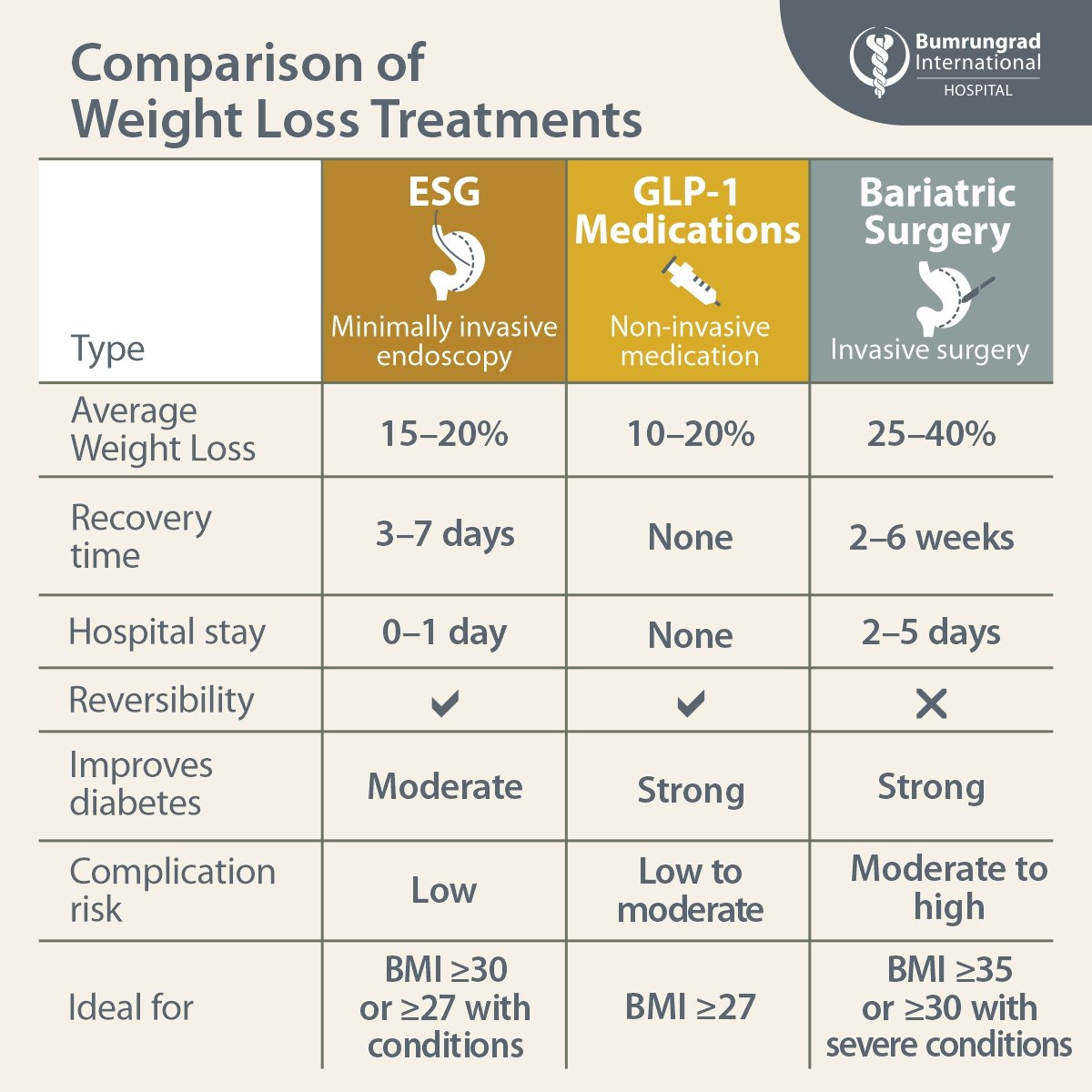ESG vs. Bariatric Surgery vs. GLP-1 Therapy: Where Do We Stand in 2025?
Obesity and metabolic conditions are among the most urgent health challenges worldwide, affecting over one-third of adults and contributing to diabetes, heart disease, and fatty liver disease. While lifestyle changes remain crucial, many people need extra support to achieve long-term weight loss.
In 2025, advanced medical options like
Endoscopic Sleeve Gastroplasty (ESG), bariatric surgery, and GLP-1 medications are transforming weight management.
Endoscopic Sleeve Gastroplasty (ESG): A Minimally Invasive Revolution
ESG is a non-surgical, incision-free procedure that uses an endoscope (a thin tube with a camera and suturing tool) inserted through the mouth to reduce stomach volume.
Key benefits of ESG:
- No external cuts or scars
- Short recovery time (3–5 days)
- Reversible and repeatable
- 15–20% average total body weight loss
- Very safe with a complication risk of less than 2%
- Does not worsen acid reflux
- Improvements in blood sugar, cholesterol, and blood pressure
Who is ESG for?
- Individuals with BMI ≥30 kg/m², or Asians with BMI 27–30 kg/m² with obesity-related health issues
- Patients who are not surgical candidates or prefer to avoid surgery
- People who haven’t achieved results with lifestyle changes alone
Bariatric Surgery: The Traditional Gold Standard
Bariatric surgery (e.g., gastric bypass, sleeve gastrectomy) permanently changes the stomach and digestive system to promote substantial weight loss.
Advantages:
- Greatest long-term weight loss (25–40%)
- Strong improvements or resolution of diabetes and other conditions
Considerations:
- Invasive with incisions
- Longer recovery (2–6 weeks)
- Higher surgical risks
- Requires lifelong dietary adjustments and vitamin supplementation
GLP-1 Medications: Powerful, Non-Surgical Support
GLP-1 receptor agonists (such as semaglutide and tirzepatide) are injectable medications that help reduce appetite, improve insulin sensitivity, and support weight loss.
Benefits of GLP-1 therapy:
- Non-invasive
- Average weight loss: 10–20% (depending on medication)
- Improved blood sugar control, lower cholesterol, and reduced cardiovascular risk
- Some patients achieve remission of type 2 diabetes
Common side effects:
- Nausea, vomiting, diarrhea, constipation
- Rare gallbladder or pancreas-related issues
- Possible muscle loss if weight loss happens too quickly without proper exercise
Considerations
- GLP-1 medications require continuous use to maintain weight loss. Most patients experience significant weight regain after discontinuation, and the long-term cost can become substantial.
ESG is a one-time procedure that may offer more durable results and better long-term cost savings.
- GLP-1 medications can lead to up to 30–40% of weight lost coming from lean muscle mass, whereas ESG tends to result in only about 10–15% muscle loss, making it more effective at preserving lean body mass during weight reduction due to its mechanical rather than hormonal weight loss mechanism.

FAQs on Weight Loss Options in 2025:
Can ESG be reversed?
Yes, ESG is reversible and can be adjusted or repeated if needed.
How is ESG different from surgical sleeve gastrectomy?
ESG is a non-surgical, incisionless procedure that reduces stomach size using sutures. While it reduces the stomach similarly to surgery, it does not remove any part of the stomach and is not the same as a sleeve gastrectomy. ESG typically offers faster recovery (3–5 days), shorter hospital stay, and lower risk of complications. Unlike surgery, ESG rarely worsens acid reflux, while up to 30–60% of patients develop or experience worsening GERD after surgical sleeve gastrectomy.
How long do I need to stay in the hospital after ESG?
Most patients stay overnight or can even return home the same day, depending on individual recovery.
Will I need to change my diet after ESG or GLP-1 therapy?
Yes! A healthier diet and lifestyle changes are essential for long-term success and to maintain your weight loss results.
How soon will I see results?
Weight loss starts within the first few weeks after ESG or starting GLP-1 therapy, with most patients seeing significant changes over 6–12 months.
Where can I get ESG and GLP-1 therapy?
At
Bumrungrad International Hospital, ESG and advanced endoscopic procedures are performed at the
GI-Broncho Endoscopy Unit, which is certified by the
EURP (Endoscopy Unit Recognition Program), powered by the
American Society for Gastrointestinal Endoscopy (ASGE). This recognition makes Bumrungrad the
first unit in Thailand and Southeast Asia to receive this prestigious accreditation — a testament to its commitment to world-class quality, safety, and patient-centered care.
A New Era for Weight Loss in 2025
As obesity rates continue to rise, combining ESG and GLP-1 therapy offers a safe, effective, and life-changing alternative to traditional surgery.
At Bumrungrad International Hospital, we are proud to lead this new era, helping patients achieve lasting weight loss and metabolic health with advanced, personalized care.
Learn more about the
Endoscopic Sleeve Gastroplasty (ESG) package and take the first step toward a healthier, happier you.
Reviewed by Asst.Prof.Dr. Veeravich Jaruvongvanich
For more information please contact:
Last modify: July 17, 2025